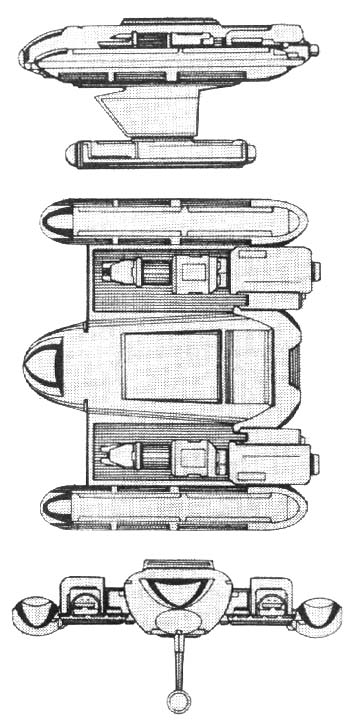«Last Updated on December 19, 2023 »
from FASA Star Trek© Starship Tactical Combat Simulator – Romulan Ship Recognition Manual (1st Edition)
NOTES:
Known Sphere Of Operation: Empire-wide use
Data Reliability: C for all models
Major Data Source: Romulan Sector Intelligence
The E-5 repair tenders, which came into service in 2261, are fleet service and support ships that extend war vessels’time-on-station and that facilitate front-line repair during war. All Romulan fleets contain several of these useful vessels so that in-transit repairs are possible for individual ships. It remains a common sight at all border outposts that maintain an F-2 Repair and Construction facility.
The E-5 uses its two retractable arms to position large components and place them in their mountings. Once placed, the components can be fitted properly by the small work pods listed as shuttlecraft in the tender’s statistics. These small pods also have retractable arms that are used for final fitting or positioning. The pods are also capable of completing most external repair jobs with the wide array of attachments for their little arms. If more detailed work than the pod can perform is required, specially-suited engineers will finish the job.
With the deterioration of relations with the Federation and the continued conflict with the Klingon Empire, planners began arming the E-5 to better supplement front-line combat repairs. Upgrades to the main warp nacelle and power system further extended the usefulness of the E-5. First fielded in 2291, the Type 2 continued in service until the late 2330’s when the Type 3 was commissioned.
The Type 3 saw the first upgrade to the main computer, with refits issued the fourth generation of the R-4M computer. Damage to several E-5s during repair operations along the Klingon boarder prompted designers to increase the number of weapons, giving the Type 3 more defensive firepower.
Although long since out of production, estimates showed about nine of these vessels were built per year. Of the 360 built, about 229 Type 3s remain in service. 12 Type 1s, 18 Type 2s and 6 Type 3s are know to have been destroyed. 4 Type 2s and 1 Type 3 have been scrapped due to damage. 10 older Type 1s were scrapped due to age. 5 Type 3s are used as training vessels. About 30 Type 1s have been sold to the private sector, four of which are still operated in conjunction with the independent F-2 facility orbiting Freeman’s Port in the Triangle. 50 Type 2s and 25 Type 3s have also been sold.
The class is named from the Romulan narvasam’al (little nest).
| Construction Data: | |||
| Model – | Type 1 | Type 2 | Type 3 |
| Ship Class – | V | V | V |
| Date Entering Service – | 2261 | 2291 | 2337 |
| Number Constructed – | 290 | 170 | Refit |
| Hull Data: | |||
| Superstructure Points – | 10 | 12 | 12 |
| Damage Chart – | B | B | B |
| Size: | |||
| Length – | 102 m | 102 m | 102 m |
| Width – | 110 m | 110 m | 110 m |
| Height – | 50 m | 50 m | 50 m |
| Weight – | 47,383 mt | 52,548 mt | 56,720 mt |
| Cargo: | |||
| Total SCU – | 110 SCU | 110 SCU | 110 SCU |
| Cargo Capacity – | 5,500 mt | 5,500 mt | 5,500 mt |
| Landing Capacity – | None | None | None |
| Equipment Date: | |||
| Control Computer Type – | R3M | R3M | R4M |
| Transporters: | |||
| Standard 9-person – | 1 | 1 | 1 |
| Emergency 20-person – | 1 | 1 | 1 |
| Cargo – | 1 | 1 | 1 |
| Other Data: | |||
| Crew – | 114 | 116 | 119 |
| Shuttlecraft – | 12 | 12 | 12 |
| Engines And Power Data: | |||
| Total Power Units Available – | 20 | 23 | 30 |
| Movement Point Ratio – | 2/1 | 2/1 | 2/1 |
| Warp Engine Type – | RWD-1 | RWD-2 | RWD-2 |
| Number – | 1 | 1 | 1 |
| Power Units Available – | 15 | 18 | 18 |
| Stress Chart – | N/O | O/Q | O/Q |
| Max Safe Cruising Speed – | Warp 7 | Warp 7 | Warp 7 |
| Emergency Speed – | Warp 8 | Warp 8 | Warp 8 |
| Impulse Engine Type – | RIB-3 | RIB-3 | RID-3 |
| Power Units Available – | 5 | 5 | 12 |
| Weapons And Firing Data: | |||
| Beam Weapon Type – | – | RB-9 | RB-9 |
| Number – | – | 3 | 6 |
| Firing Arcs – | – | 1 p/f/s, 1 p/a, 1 s/a | 2 p/f/s, 2 p/a, 2 s/a |
| Firing Chart – | – | W | W |
| Maximum Power – | – | 6 | 6 |
| Damage Modifiers: | |||
| +3 | – | (1-8) | (1-8) |
| +2 | – | (9-16) | (9-16) |
| +1 | – | (17-20) | (17-20) |
| Shield Data: | |||
| Deflector Shield Type – | RSD | RSE | RSX |
| Shield Point Ratio – | 1/1 | 1/2 | 1/2 |
| Maximum Shield Power – | 8 | 8 | 25 |
| Combat Efficiency: | |||
| D – | 40.3 | 62.2 | 96.2 |
| WDF – | 0.0 | 19.5 | 38.4 |

